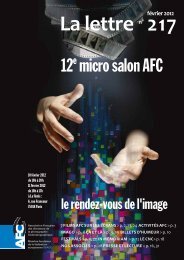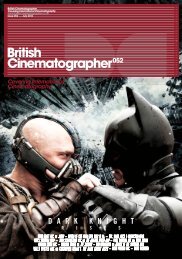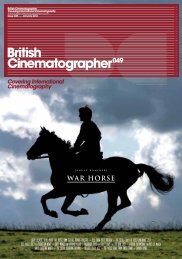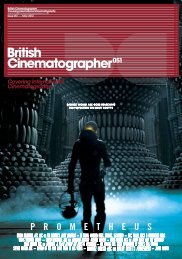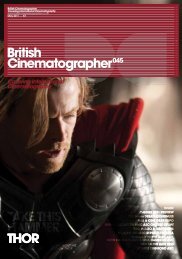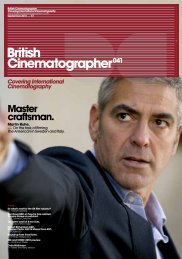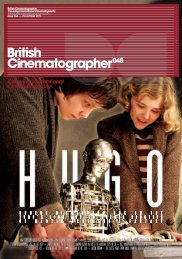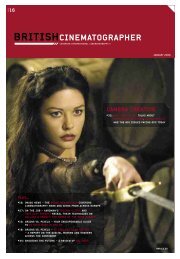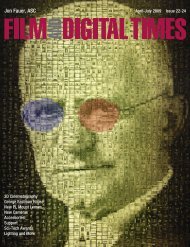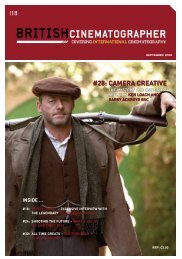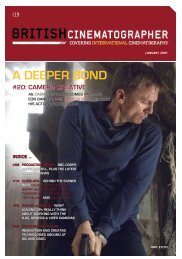Create successful ePaper yourself
Turn your PDF publications into a flip-book with our unique Google optimized e-Paper software.
Interview with Franz Kraus<br />
This idea was hatching in your mind a long time. I remember, it was<br />
exactly ten years ago. You and I were at NAB with the latest little<br />
consumer digital still cameras. You held it up, and said “This is the<br />
future.” I asked, “How long?” You said, “2010.” Your prediction was<br />
correct ten years ago.<br />
I think the technology roadmaps are there. An engineer can read<br />
that and know what will happen with consumer electronics and<br />
how much can become a tool for professional media production.<br />
Based on the success of Alexa, we are very confident that we will<br />
have technology for the next generations of product. The concept<br />
we have is to carry as much of the positive attributes from the<br />
analog area to the digital world.<br />
We can’t change Moore’s Law; we need to watch very carefully<br />
to benefit from Moore’s Law. Our belief with the sensor is that<br />
it isn’t following Moore’s Law as faithfully because the demands<br />
are driven by other industries. The concept we have in mind is<br />
that whoever buys an Alexa will not be left on their own in future<br />
years. That means we need to have a service network making sure<br />
that whenever something happens, we are close by to help. We<br />
will also be available to make upgrades or add modules. And that<br />
requires trained service personnel who can look after service and<br />
upgrades.<br />
We needed to be compact. So we decided to go with encapsulated<br />
electronics and a heat pipe system. That comes at a cost. It adds<br />
price, it adds weight, it adds power consumption. So it doesn’t,<br />
unfortunately, come for free. But ultimately I am convinced it will<br />
be part of why Alexa is so robust. We control the temperature<br />
of both the sensor and the image processing electronics. In the<br />
regular world, you would not need this. But in extremes, if you<br />
don’t do it, probably the images won’t be consistent. We decided<br />
which ingredients each and every camera with the ARRI label<br />
needs to have. Those are elements where we think we differentiate<br />
ourselves from others.<br />
Where do you see the viewfinder going: optical or electronic?<br />
Without any question, high-end cinematographers are asking<br />
for optical viewfinders—especially the ones who operate their<br />
own camera. They grew up knowing exactly what to expect when<br />
looking into an optical finder. It won’t be large numbers, but it’s a<br />
larger number than you would expect. We are close to a decision.<br />
We are reviewing it now.<br />
I vote for it. What about film? What do you see as the role of film,<br />
on high end productions? What’s the turning point?<br />
I think there are very many variables. If the motion picture industry<br />
has learned from the professional still photo industry, then<br />
probably the industry will be more intelligent, not dropping service,<br />
not over-pricing.<br />
Today, if you shoot a picture that is not 3D or relying heavily on<br />
CGI, probably the best thing is still film. It is future-proof. There<br />
are no archive issues. You can take it to any resolution. There are<br />
great DI tools. It’s commonplace throughout the world. There’s<br />
an established worldwide 4K capable workflow. So there is headroom.<br />
Why throw that away?<br />
There are other productions, 3D features, TV drama or features<br />
with lots of CGI, where digital capture makes a lot of sense. It is<br />
interesting that we also see a small Renaissance of film (2 perf and<br />
Super 16) for TV programs in some countries because of the film<br />
look. <strong>Film</strong> has a unique look, and it probably doesn’t make sense<br />
to work very hard to make digital look like film when you can<br />
simply shoot film instead.<br />
How did you convert an entire area of your analog camera factory<br />
to digital production—almost overnight?<br />
We changed many things because we rely on many components.<br />
If we want to assure quality, we need to have extensive testing and<br />
certification. So, we invested a lot in that. In selecting very good<br />
suppliers, as we have with digital high-end products, we knew<br />
them from the Arrilaser, the scanner, the HD-IVS—all with components<br />
that are very compact. We knew who would be the right<br />
partners.<br />
People may think, “Well, they have film cameras, how can it be<br />
that they have a successful digital camera? That’s probably luck.”<br />
No, it was hard work over many years, starting with the Arrilaser.<br />
The design of the Arrilaser was started in 1995, and the product<br />
was launched in 1998. We had a great team, with very solid internal<br />
and external capabilities. Whatever we could develop from<br />
where we were to the next generation, we did. We have partners<br />
going back many, many years. They have grown as well.<br />
What about the sensor development? How did you arrive at that?<br />
We have a great guy in our R&D team who worked more than 10<br />
years ago with a professor from the Munich University on the design<br />
of our first Cine format CMOS sensor and successfully carried<br />
it through several revisions. We learned to create an organic,<br />
film-like image from digital capture. All that experience, combined<br />
with substantial color science from another long-standing<br />
ARRI R&D member, led to the specification, characteristics, and<br />
structure of the rather complex but extremely powerful custom<br />
Alexa CMOS sensor and the Alexa imaging front end and color<br />
processing.<br />
Alexas are built by some of the same people who were building Arricams.<br />
That’s interesting.<br />
And there are people who had worked on the Arrilaser, the Arriscan,<br />
and on image processing software. It is not like converting<br />
a precision mechanical engineer to an electronic engineer. To<br />
build Alexa cameras is not a trivial thing. You need to do things in<br />
the right order and to make sure that it works at the end. We need<br />
to have all the skill from the analog camera world combined with<br />
new talent to make this work.<br />
In summary?<br />
I think it is valuable to look at our <strong>Digital</strong> Intermediate products.<br />
Without the DI products, we would not have the D-20. Without<br />
the laser, we wouldn’t have started the D-20 and the scanner. And<br />
the success of the laser was the ground-laying part of our digital<br />
camera business.<br />
If the owners had not been convinced that this risk had a good<br />
chance to become successful, maybe they would not have gone<br />
this route, and would have asked “Can’t we brand another product<br />
and add value in distribution?” There had been several other<br />
opportunities, but none of them would have left ARRI in the position<br />
of owning and mastering digital technology. That is probably<br />
the most important achievement of these last years, looking at the<br />
long term success of ARRI as a company.<br />
Dec 2010<br />
15



